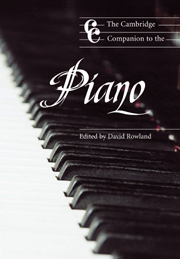Book contents
3 - The piano since c.1825
from Part one - Pianos and pianists
Published online by Cambridge University Press: 28 September 2011
Summary
The concert grand to c.1860
Piano making in the years c.1825–60 was characterised by the development of ever more powerful and sonorous instruments. In order to achieve their aims, makers continued to experiment with all aspects of piano design and as each small change was made in one part of the instrument, modifications were inevitably required elsewhere. So, for example, greater string tension necessitated a stronger frame and heavier hammers, which in turn led to a deeper touch. However, a deeper touch made fast note repetition more difficult, so a new kind of action was invented. It was a combination of hundreds of such developments (each of them painstakingly patented by makers, and listed by piano historians) that led to the emergence, around 1860, of grand pianos which were essentially the same as those used on concert platforms today.
A wooden structure was sufficient to cope with the string tension on early grand pianos. Nevertheless, small amounts of metal were used by some makers to strengthen the most vulnerable parts of the piano's structure. The first Broadwood grands, for example, from the 1780s, had small hoops of metal between the wrestplank (the block of wood which holds the tuning pins) and belly rail (the substantial wooden frame member that runs across the width of the piano and supports the end of the soundboard nearest the player) in order to prevent the gap closing through which the hammers pass on their way to hit the strings. Viennese makers soon adopted the same practice having first used wooden supports for the same purpose.
- Type
- Chapter
- Information
- The Cambridge Companion to the Piano , pp. 40 - 56Publisher: Cambridge University PressPrint publication year: 1998
- 3
- Cited by



